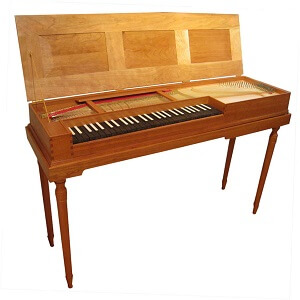Clavichord
 A clavichord is a keyboard instrument whose sound is generated by a brass blade or ‘tangent’ pushing up against a pair of strings.
A clavichord is a keyboard instrument whose sound is generated by a brass blade or ‘tangent’ pushing up against a pair of strings.
The clavichord’s mechanism is disarmingly simple. Each key lever has a brass blade called a tangent at its end that pushes up against pairs of strings when the key is pressed down. This direct connection with the strings allows the player not only to make dynamic contrasts but also to sustain and control the sound.
Most clavichords are strung in pairs so are said to be double-strung. Yellow brass (70% Copper, 30% Zinc) is the usual stringing material, and the thickness of the wire varies from bass to treble. Heavier red brass (90% Copper, 10% Zinc) strings, or even overspun strings might be used in the extreme bass. The smallest clavichords have fewer pairs of strings than keys, resulting in an easy-to-tune, smaller and (because of the lesser tension) often seemingly louder instrument. Similar to guitars and lutes, this arrangement is called “fretting”, and a clavichord could said to be either double- or triple-fretted, according to whether the strings are shared in twos or threes throughout most of the compass. The light weight and small size of fretted clavichords enable them to be taken anywhere. Many of the surviving original small clavichords lack legs, so perhaps they were table-top instruments, or meant to be played on one’s knees in a stage coach or in bed. (One wag once remarked that the clavichord was the only musical instrument that a person in one half of a double bed could play without disturbing the person in the other half—and he might well have been right!)